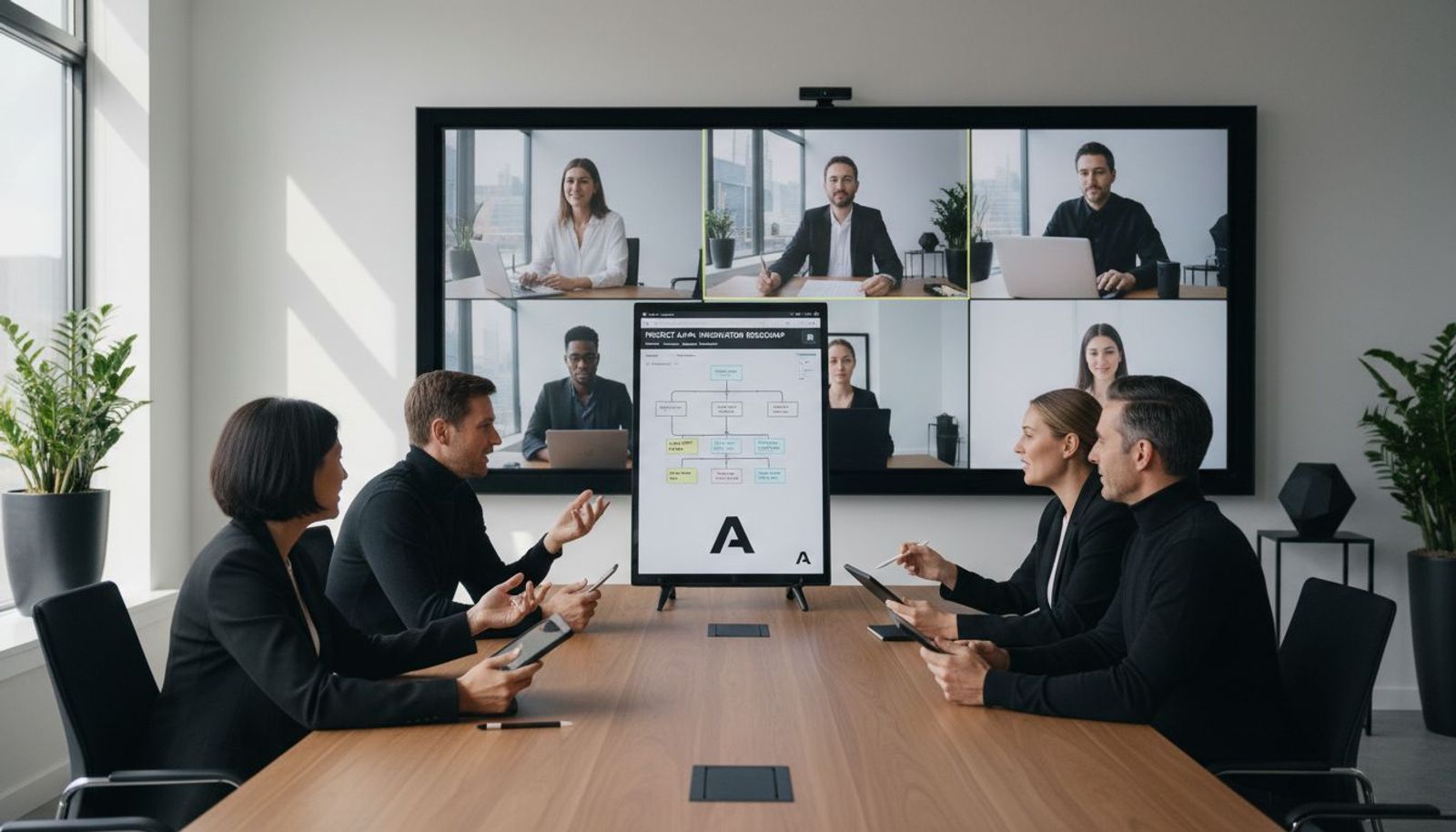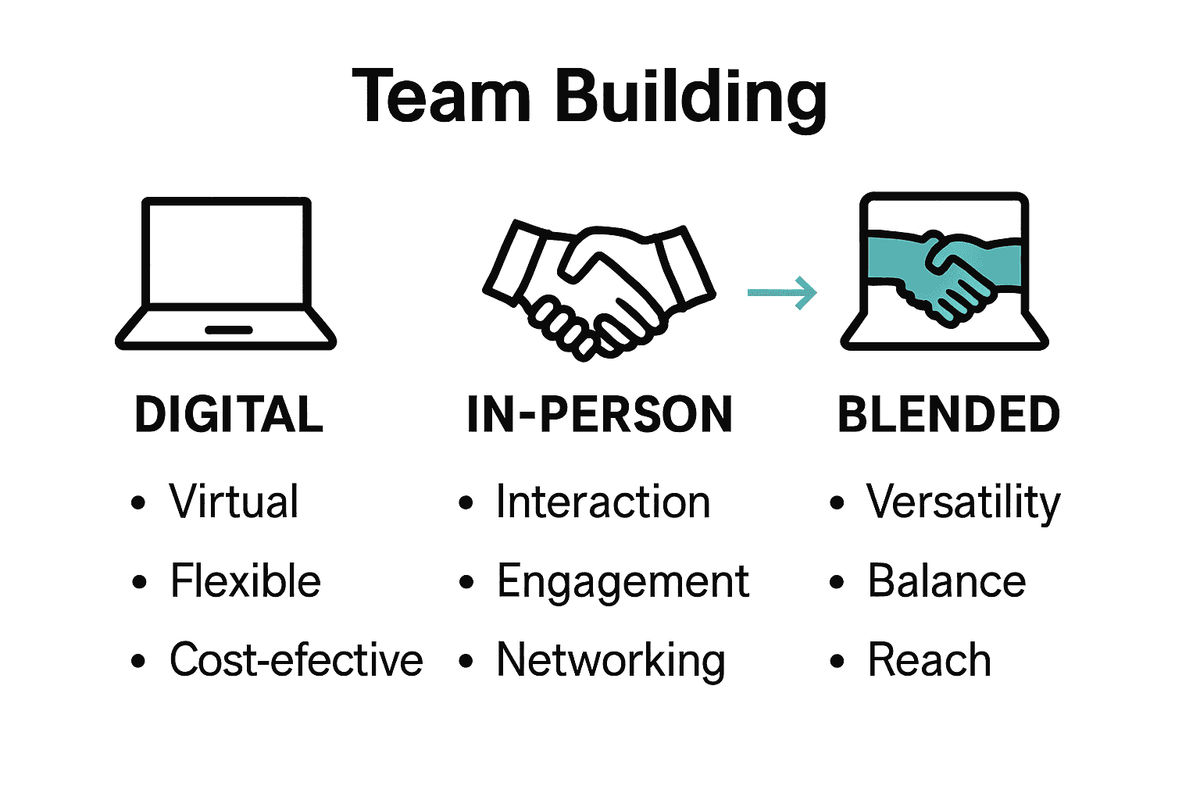Blended Team Building: Complete Guide for Organizations
November 14, 2025

Over half of today’s teams include at least one remote or hybrid member, changing how organizations build trust and connection. Teams are no longer confined to a single office, making it harder to foster real collaboration. Blended team building combines the strengths of in-person and digital methods, helping groups connect in ways that work for every member. Discover practical steps to make your team stronger, more flexible, and genuinely engaged—no matter where they work.
Table of Contents
- Blended Team Building Defined and Explained
- Types of Blended Team Building Formats
- How Blended Team Building Works in Practice
- Key Benefits and Critical Success Factors
- Common Challenges and How to Overcome Them
Key Takeaways
| Point | Details |
|---|---|
| Blended Team Building | Integrates in-person and virtual interactions to enhance team cohesion and performance in modern, distributed workforces. |
| Key Benefits | Offers increased flexibility, improved communication, and personalized engagement experiences, leading to heightened productivity and job satisfaction. |
| Critical Success Factors | Successful implementation requires robust technology, inclusive design, clear communication strategies, and leadership commitment. |
| Challenges & Solutions | Overcome obstacles like unequal engagement and communication breakdowns by developing inclusive frameworks and providing regular training opportunities. |
Blended Team Building Defined and Explained
Blended team building represents a modern approach to organizational development that strategically merges traditional face-to-face interactions with digital collaboration techniques. According to sajhrm, this methodology integrates in-person team development activities with virtual components, aiming to enhance team cohesion and performance across both physical and digital environments.
The core philosophy of blended team building recognizes that modern workforces are increasingly distributed, spanning multiple geographic locations and work arrangements. By combining offline and online engagement strategies, organizations can create more inclusive, flexible team-building experiences that accommodate remote workers, hybrid teams, and traditional office settings. These approaches might include virtual team games, in-person workshops, digital collaboration platforms, and interactive online challenges that break down communication barriers.

Key characteristics of effective blended team building include:
- Seamless integration of physical and digital interaction modes
- Flexibility to accommodate different work environments
- Scalable approaches that work for teams of various sizes
- Technology-enabled connection methods
- Opportunities for both synchronous and asynchronous engagement
While traditional team-building methods often relied exclusively on physical proximity, blended approaches recognize that meaningful connections can happen through multiple channels. The goal is not just to create momentary interactions, but to foster genuine understanding, trust, and collaborative potential across diverse team configurations.
Types of Blended Team Building Formats
Blended team building formats represent a diverse array of collaborative approaches that strategically combine physical and virtual interaction methods. According to sajhrm, these formats encompass activities that integrate physical presence with virtual participation, such as combined workshops and online collaborative projects.
These formats can be categorized into several key implementation strategies:
- Hybrid Workshop Experiences
- In-person core session with virtual breakout rooms
- Physical location with remote participant streaming
- Interactive digital collaboration during face-to-face meetings
- Digital-Physical Challenge Series
- Multi-stage team challenges crossing digital and physical domains
- Competitive games combining online and offline components
- Performance tracking across different interaction platforms
- Synchronous and Asynchronous Engagement
- Real-time virtual meetings complemented by offline team activities
- Online skill-building modules with in-person practical application
- Self-paced digital learning integrated with group coaching sessions
Organizations implementing these blended formats gain significant advantages in team dynamics.
Team building methods that leverage multiple interaction channels create more inclusive, flexible, and engaging experiences that accommodate diverse workforce preferences and working styles. The key is creating seamless transitions between digital and physical team-building environments, ensuring every team member feels connected and valued.

How Blended Team Building Works in Practice
Blended team building transforms traditional team development by creating dynamic, flexible interaction frameworks that bridge physical and digital spaces. According to sajhrm, successful implementation requires establishing trust, clear communication, and flexibility to adapt to both virtual and physical team interactions.
The practical implementation of blended team building involves several strategic approaches:
- Technology Integration
- Select collaborative platforms supporting multiple communication modes
- Ensure seamless transitions between digital and physical interactions
- Choose tools that accommodate various participant engagement levels
- Communication Protocols
- Establish clear expectations for online and offline participation
- Create inclusive communication channels
- Design engagement methods that work across different environments
Successful blended team building requires nuanced planning and adaptive strategies. Successful team-building tips emphasize the importance of creating structured yet flexible experiences that respect individual preferences while maintaining collective momentum. Organizations must design experiences that feel natural, engaging, and meaningful regardless of whether participants are connecting digitally or in-person.
Ultimately, the goal is to create a holistic team development approach where physical and digital interactions complement each other, breaking down traditional barriers and fostering a more connected, collaborative workforce. By thoughtfully integrating multiple engagement modes, teams can build stronger relationships, improve communication, and enhance overall organizational performance.
Key Benefits and Critical Success Factors
Blended team building offers transformative advantages for modern organizations seeking to optimize team performance and engagement. According to sajhrm, the key benefits include enhanced connectedness, increased productivity, and improved job satisfaction, achieved through establishing trust and clear communication strategies.
Key Benefits of Blended Team Building:
- Increased team flexibility and adaptability
- Reduced geographical and technological barriers
- Personalized learning and engagement experiences
- Improved communication across diverse work environments
- Cost-effective alternative to traditional team development approaches
Critical Success Factors involve a strategic approach to implementation:
- Robust technological infrastructure
- Inclusive design considering diverse participant needs
- Continuous feedback and adaptation mechanisms
- Clear communication protocols
- Leadership commitment and active participation
Team-building best practices demonstrate that successful blended approaches require more than just technological tools. They demand a holistic understanding of team dynamics, individual preferences, and organizational culture. The most effective programs create seamless, engaging experiences that feel natural and meaningful, regardless of whether interactions occur digitally or in physical spaces.
Common Challenges and How to Overcome Them
Blended team building presents unique obstacles that organizations must strategically navigate. According to sajhrm, the most significant challenges include maintaining trust and effective communication, which require proactive leadership and adaptive strategies to successfully overcome.
Primary Challenges in Blended Team Building:
- Technology compatibility and access disparities
- Unequal participant engagement across digital and physical platforms
- Communication breakdown between remote and in-person team members
- Maintaining consistent team energy and motivation
- Managing different technological skill levels
Strategic Mitigation Approaches:
- Conduct comprehensive technology assessments
- Develop inclusive participation frameworks
- Create standardized communication protocols
- Implement regular skill-leveling training
- Design engagement strategies that accommodate diverse participant needs
Understanding team building tips reveal that successful blended approaches demand more than technical solutions. They require empathetic leadership, continuous learning, and a commitment to creating experiences that feel authentic and meaningful. Organizations must remain flexible, consistently gathering feedback and adapting their strategies to ensure every team member feels valued, connected, and empowered, regardless of their physical or digital participation mode.
Elevate Your Blended Team Building with Interactive Quiz Games
Blended team building thrives on seamless integration of in-person and virtual interactions to boost trust, communication, and engagement. If your organization faces challenges like unequal participation or maintaining consistent energy across digital and physical channels, leveraging customizable and engaging activities can transform your team's connection. Quizado.com offers tailored quiz experiences inspired by famous game shows that make team building inclusive and fun whether your teams are remote, in-office, or hybrid.

Experience the power of game-based collaboration at Quizado where you can create personalized quiz games that fit your unique team needs. Designed to break down communication barriers while igniting excitement, our platform supports remote control via smartphones, branding integration, and flexible play modes. Don’t wait to bring your blended teams closer through interactive challenges that foster genuine teamwork. Start crafting your custom team-building event today and see immediate improvements in engagement and productivity at Quizado.com.
Frequently Asked Questions
What is blended team building?
Blended team building is a modern approach that combines traditional face-to-face interactions with digital collaboration techniques to enhance team cohesion and performance across different work environments.
What are the key benefits of blended team building?
Key benefits include increased flexibility, improved communication, reduced geographical barriers, personalized engagement experiences, and overall enhancement in team productivity and job satisfaction.
How does blended team building work in practice?
Blended team building works by integrating technology with organized activities that facilitate both online and offline interactions, allowing teams to connect meaningfully regardless of their physical location.
What challenges might organizations face when implementing blended team building?
Organizations may face challenges such as technology compatibility, unequal engagement between remote and in-person team members, and maintaining communication and motivation levels across different participation modes.



